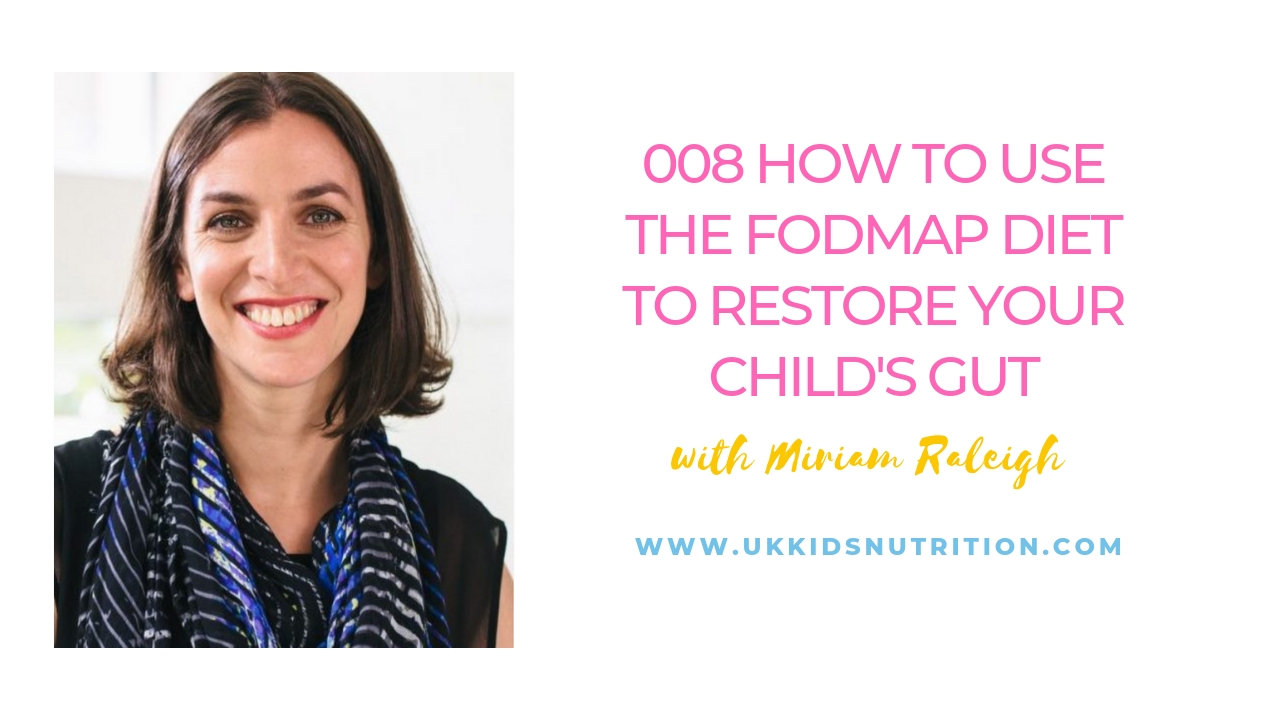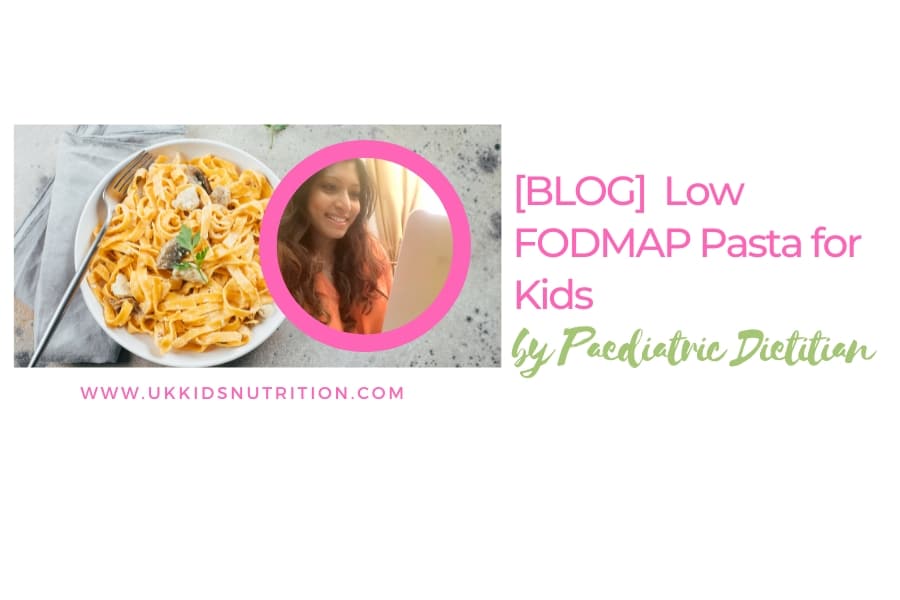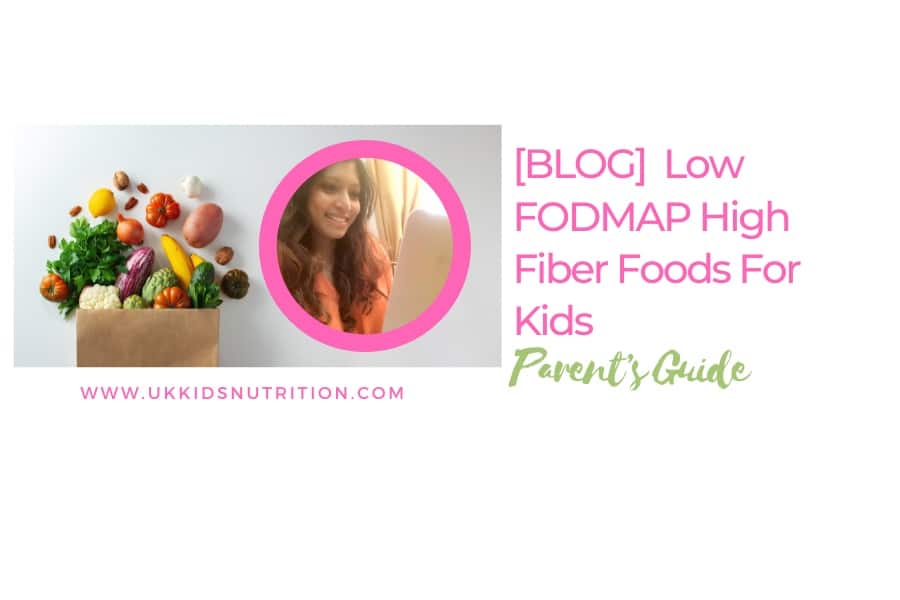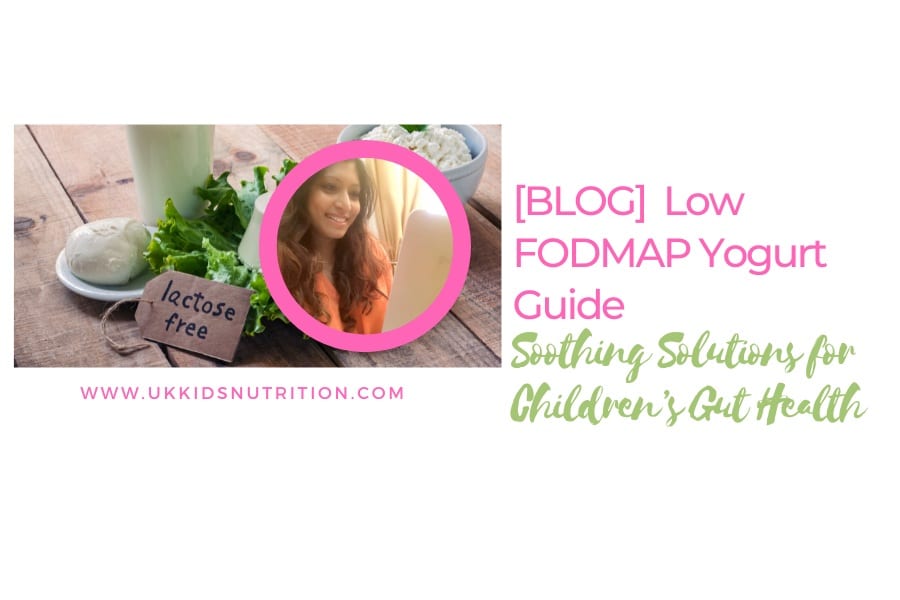Subscribe: Apple Podcast | Email | Spotify | Stitcher
Interested in the low FODMAP diet for children?
Then it is my absolute pleasure to introduce you to my long-time friend and dietitian Miriam Raleigh, a registered dietitian based in Australia.
She’ll be taking us through the low FODMAP diet for children used in irritable bowel syndrome and how to try it as early as the weaning phase if you suspect your baby has difficulty digesting certain foods.
What are FODMAPs?
FODMAPs are a group of short-chain carbohydrates that your child’s gut may have difficulty digesting. They can be poorly absorbed in the small part of the bowel (small intestines). Unabsorbed, they remain in the small intestine where bacteria ferment these to produce gas.
F . Fermentable
O . Oligosaccharides (fructans and galactans)
D Disaccharides (lactose)
M . Monosaccharides (fructose)
And
P . Polyols (sugar alcohols)
FODMAPs are usually absorbed in the small intestine and fermented in the large part of the bowel.
Some children’s bodies may not handle FODMAPs well and can suffer from functional gastrointestinal disorders called irritable bowel syndrome.
In IBS, children may experience IBS symptoms such as constipation, diarrhoea, bloating, flatulence and abdominal pain or discomfort.
The low FODMAP diet for children is one tool to manage their IBS related digestive issues.
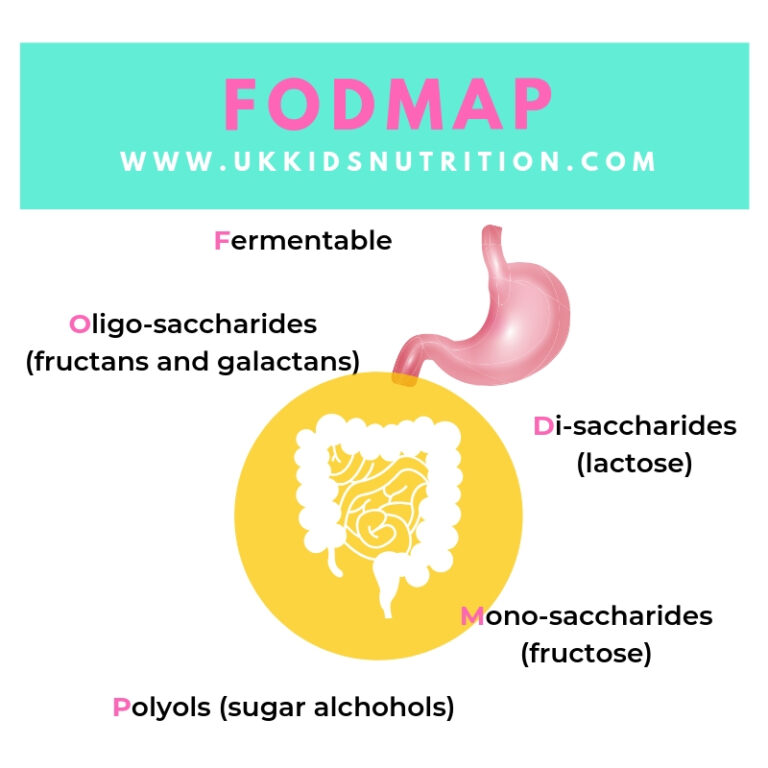
If you are wondering whether a low FODMAP diet could work for your child, it’s really important to speak to your child’s GP or paediatric gastroenterologist first.
They can organise a set of tests first (though these are not always necessary to start the diet).
Can kids have IBS?
Are you worried that your child may be suffering from IBS?
While it may seem rare, many children with toddler diarrhoea (without milk allergy) or unexplained diarrhoea and constipation in older children may be undiagnosed IBS.
So, if your child has been experiencing digestive issues, it’s worth considering whether IBS could be the cause.
In adult patients, a low FODMAPs diet is often recommended.
The low FODMAP diet for children is an adaptation or a gentle version of the diet.
It is often used to manage diarrhoea, constipation, bloating and tummy pain that is not related to allergy or other causes.
Low FODMAP diet for children
If your child has been diagnosed with IBS, a simplified version of the low FODMAP diet may be recommended.
The Happy Belly Club understands that children with IBS need special attention and care.
I’m here to support you every step of the way.
The simplified version of the low FODMAPs diet has been tailored to suit the unique needs of children and is designed to give them relief from the symptoms of IBS.
During the short-term elimination phase, I’ll guide you in limiting high FODMAP foods to help your child’s digestive system recover.
This means your child will mostly eat low FODMAP foods.
Our approach is based on the Happy Belly Formula, a proven framework that makes the low FODMAP diet easy to follow and implement.
I understand that navigating the low FODMAP diet for kids can be challenging, which is why we provide you with all the resources and guidance you need.
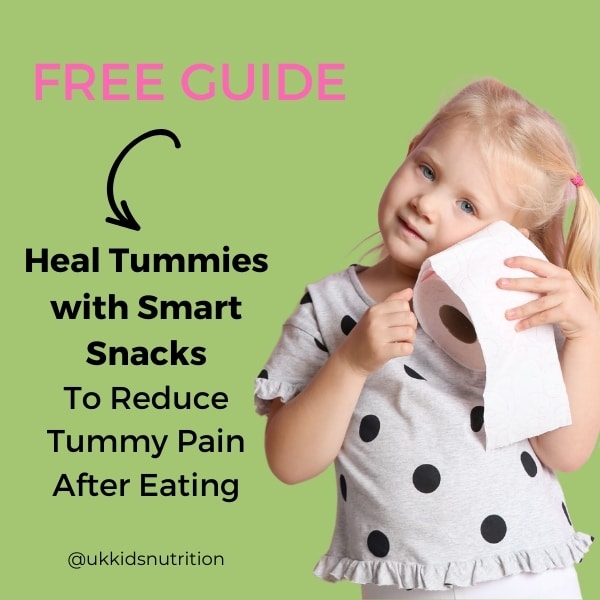
FODMAPs myths
A low FODMAPs diet isn’t a lifestyle choice. When you work with a paediatric dietitian, your child’s dietitian will guide you through a 4-6 week exclusion phase. Your child will be asked to follow a diet low in FODMAPs or something called the FODMAP gentle diet.
Why low FODMAPs? The first phase of the FODMAPs diet improves your child’s most troublesome symptoms like tummy pain linked with constipation or loose stools.
However, Miriam Raleigh explains that it’s best not to rely on Dr Google for the list of low FODMAPs foods.
You can read a lot about FODMAPs but you’ll quickly get fed up with the amount of inaccurate data published online.
Whilst the internet gets noisier, save your sanity and hours of searching in the dark by speaking to your dietitian.
You’ll be provided with a list of accurate resources to help you navigate this artificial but effective diet to restore your child’s gut.
Power hour education sessions with an expert can help streamline your thoughts, answer burning questions and help you design a purposeful yet nutritionally balanced low FODMAPs diet for the exclusion diet phase.
Example of FODMAPs
Fructans (also known as fructooligosaccharides) or FOS are chains of sugar fructose of different lengths.
Galactans are known as galactic-oligosaccharides (GOS) which are chains of the sugar galactose.
Low FODMAP fruit and vegetables
- clementines
- carrots
- blueberries
- rock melon
- green beans
- broccoli
Foods high in fructans or GOS and other FODMAPs include:
- wheat and rye-based foods such as bread, pasta, and breakfast cereals (examples of fermentable oligosaccharides)
- vegetables like onion, garlic, legumes (chickpeas and lentils), leeks
- fruit such as apples, nectarine, watermelon
- some nuts and seeds
- processed foods where FOS has been added as a prebiotic
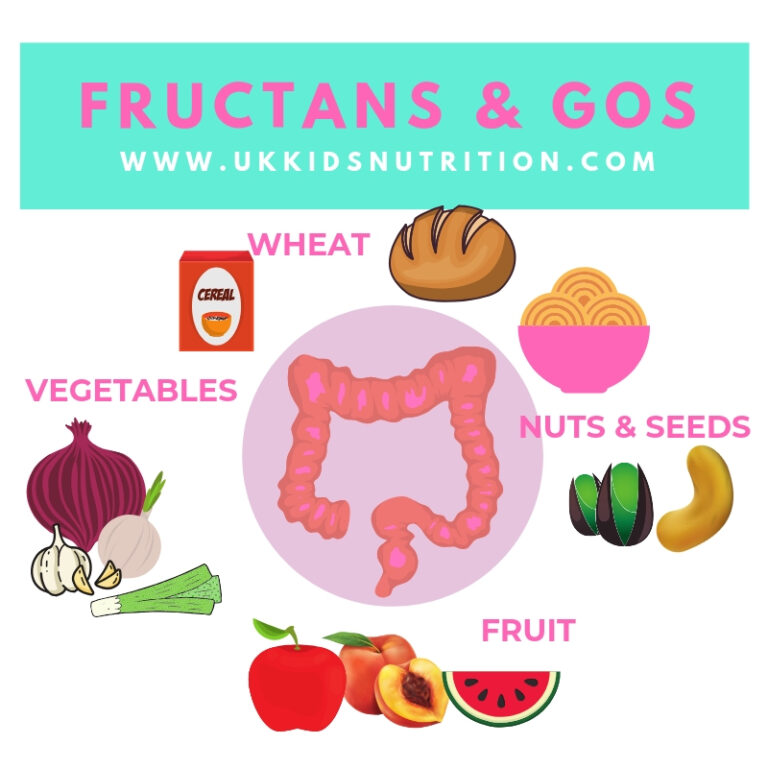
What is lactose?
Lactose is the main type of carbohydrate found in milk and dairy products.
Your child’s doctor can organise a lactose breath test if you suspect lactose malabsorption.
This is not a dairy-free diet.
If you identify that lactose is problematic and drives your child’s loose stools, don’t worry as they may still be able to enjoy small amounts of regular milk, cheese and yoghurt.

FODMAP fruit: foods high in fructose
Nearly all fruits and vegetables contain fructose.
For a happier gut, when implementing the low FODMAP diet for children, only the fruit high in fructose is reduced during the elimination phase.
These only need to be restricted if your child has fructose malabsorption.
You’ll be relieved to know that vegetables with excess fructose are asparagus and artichokes which children don’t tend to eat in large quantities.
As part of the low FODMAP trial, it’s still important that children meet their daily quota of five servings of fruit and vegetables daily.
Your dietitian may suggest restricting fruit with excess fructose such as:
- apples
- pears
- dried fruit
- fruit juice
Don’t despair, there’s plenty on the list that your child can still enjoy such as bananas, berries and clementines.
When you work with a children’s dietitian you’ll find that diet can still be carefully balanced with sufficient calories from the major food groups such as carbohydrates, fat, protein, fruit and vegetables.
If necessary the diet may be topped up with a suitable vitamin and mineral supplement.
Still, the emphasis will be on encouraging children to get their daily dose of goodness through whole grains and veggie-inspired dishes.
What are sugar polyols?
These are sugar alcohols such as sorbitol, mannitol and xylitol.
They can be found naturally in fruits and vegetables such as apples, some types of pear and cauliflower.
Some foods can be artificially sweetened with the above, therefore always check food labels of low-calorie or sugar-free packaged food items.
Also, look out for ingredients like fructose corn syrup which can also trigger IBS symptoms in some children.
Why is the low FODMAP diet not a long-term solution for children’s gut symptoms?
The goal of the diet is to identify which of the FODMAP sugars are troublesome for your child’s gut.
When you identify which FODMAP group are the problem during the reintroduction phase, your dietitian will help you identify how much of these your child can eat without experiencing symptoms of constipation or diarrhoea.
Monash University is the founder of the FODMAP diet.
They emphasise how important it is to reintroduce high FODMAP foods back into the diet to promote the growth of good bacteria.
This is because some high FODMAPSs are also prebiotics and a source of fibres. These foods are therefore crucial for feeding and nurturing the overall composition of your child’s gut microbiota.
For breakfast ideas see 10 Delicious Low Fodmap Breakfast Recipes.
The Bottomline
The low FODMAPs diet is more commonly used as diet therapy for adults with IBS.
Roughly 1 out of 10 children suffer from IBS.
Relief from symptoms such as persisting constipation and diarrhoea of unknown cause in children may be solved through a low FODMAPs diet trial, within just two weeks of starting the diet.
The low FODMAP diet for children should never be started at home without the supervision of an experienced dietitian with appropriate FODMAP training. Please speak to your child’s doctor or IBS paediatric dietitian for further help and advice.
Alternatively, you’ll find that my Happy Belly Club will help a lot.
The Happy Belly Club provides you with access to a wealth of information and support from an experienced paediatric dietitian who has IBS herself.
So, if your child has been diagnosed with IBS, join the Happy Belly Club today and give your child the best possible care.
Let Me Help
Would you like to meet a children’s dietitian who has successfully helped families solve their nutrition problems from around the world?
Whether you are worried about picky eating, food allergies or need help with suspected IBS for your child, I’ll help you manage these with confidence.
For bookings and enquiries email me at [email protected] or book a free 15-minute call to discuss how I can help you.
